Quantitative Study on Improved Budyko-Based Separation of Climate and Ecological Restoration of Runoff and Sediment Yield in Nandong Underground River System
Abstract
1. Introduction
2. Materials and Methods
2.1. Study Region
2.2. Data
2.3. Method
2.3.1. Detection of Abrupt Point
2.3.2. Budyko Framework
2.3.3. Runoff Elasticity and Variation
2.3.4. Elasticity and Change of Sediment Yield
3. Result
3.1. Hydrological and Meteorological Changes
3.2. Sensitivity Assessment and Quantitative Analysis of Runoff Changes
3.3. Sensitivity Assessment and Quantitative Analysis of Sediment Changes
4. Discussion
4.1. Differences with Previous Models
4.2. Variation of Runoff and Sediment Yield
4.3. Elasticity of Runoff and Sediment Yield
5. Conclusions
Author Contributions
Funding
Data Availability Statement
Acknowledgments
Conflicts of Interest
References
- Piao, S.; Wang, X.; Park, T.; Chen, C.; Lian, X.; He, Y.; Bjerke, J.W.; Chen, A.; Ciais, P.; Tommervik, H.; et al. Characteristics, drivers and feedbacks of global greening. Nat. Rev. Earth Environ. 2020, 1, 14–27. [Google Scholar] [CrossRef]
- Chen, C.; Park, T.; Wang, X.; Piao, S.; Xu, B.; Chaturvedi, R.K.; Fuchs, R.; Brovkin, V.; Ciais, P.; Fensholt, R.; et al. China and India lead in greening of the world through land-use management. Nat. Sustain. 2019, 2, 122–129. [Google Scholar] [CrossRef] [PubMed]
- Fu, B.; Wang, S.; Liu, Y.; Liu, J.; Liang, W.; Miao, C. Hydrogeomorphic Ecosystem Responses to Natural and Anthropogenic Changes in the Loess Plateau of China. Annu. Rev. Earth Planet. Sci. 2017, 45, 223–243. [Google Scholar]
- Qiu, J. China drought highlights future climate threats. Nature 2010, 465, 142–143. [Google Scholar] [CrossRef] [PubMed]
- Zhao, B.; Lei, H.; Yang, D.; Yang, S.; Santisirisomboon, J. Runoff and sediment response to deforestation in a large Southeast Asian monsoon watershed. J. Hydrol. 2022, 606, 127432. [Google Scholar] [CrossRef]
- Qin, Y.; Xiao, X.; Dong, J.; Zhang, Y.; Wu, X.; Shimabukuro, Y.; Arai, E.; Biradar, C.; Wang, J.; Zou, Z.; et al. Improved estimates of forest cover and loss in the Brazilian Amazon in 2000–2017. Nat. Sustain. 2019, 2, 764–772. [Google Scholar] [CrossRef]
- Immerzeel, W.W.; van Beek, L.P.H.; Konz, M.; Shrestha, A.B.; Bierkens, M.F.P. Hydrological response to climate change in a glacierized catchment in the Himalayas. Clim. Change 2012, 110, 721–736. [Google Scholar] [CrossRef]
- Donnelly, C.; Greuell, W.; Andersson, J.; Gerten, D.; Pisacane, G.; Roudier, P.; Ludwig, F. Impacts of climate change on European hydrology at 1.5, 2 and 3 degrees mean global warming above preindustrial level. Clim. Change 2017, 143, 13–26. [Google Scholar] [CrossRef]
- Sorg, A.; Bolch, T.; Stoffel, M.; Solomina, O.; Beniston, M. Climate change impacts on glaciers and runoff in Tien Shan (Central Asia). Nat. Clim. Change 2012, 2, 725–731. [Google Scholar] [CrossRef]
- Bates, P.D.; Quinn, N.; Sampson, C.; Smith, A.; Wing, O.; Sosa, J.; Savage, J.; Olcese, G.; Neal, J.; Schumann, G.; et al. Combined Modeling of US Fluvial, Pluvial, and Coastal Flood Hazard Under Current and Future Climates. Water Resour. Res. 2021, 57, e2020WR028673. [Google Scholar] [CrossRef]
- Luo, Y.; Yang, Y.; Yang, D.; Zhang, S. Quantifying the impact of vegetation changes on global terrestrial runoff using the Budyko framework. J. Hydrol. 2020, 59. [Google Scholar] [CrossRef]
- Jiang, Z.; Lian, Y.; Qin, X. Rocky desertification in Southwest China: Impacts, causes, and restoration. Earth-Sci. Rev. 2014, 132, 1–12. [Google Scholar] [CrossRef]
- Lan, F.; Zhao, Y.; Jiang, Z.; Yu, Y.; Li, Y.; Caballero-Calvo, A.; Senciales González, J.M.; Rodrigo-Comino, J. Exploring long-term datasets of land use, economy, and demography variations in karst wetland areas to detect possible microclimate changes. Land Degrad. Dev. 2022, 33, 2743–2756. [Google Scholar] [CrossRef]
- Li, Y.Q.; Jiang, Z.C.; Chen, Z.H.; Yu, Y.; Lan, F.N.; Shan, Z.J.; Sun, Y.J.; Liu, P.; Tang, X.B.; Rodrigo-Comino, J. Anthropogenic Disturbances and Precipitation Affect Karst Sediment Discharge in the Nandong Underground River System in Yunnan, Southwest China. Sustainability 2020, 12, 6. [Google Scholar] [CrossRef]
- Huang, P.; Song, J.; Wu, Q.; Sun, H.; Mao, R.; Cheng, D.; Zhang, J.; Shi, Y. The ecohydrological effects of climate and landscape interactions within the Budyko framework under non-steady state conditions. Catena 2022, 217, 106481. [Google Scholar] [CrossRef]
- Zabaleta, A.; Meaurio, M.; Ruiz, E.; Antiguedad, I. Simulation climate change impact on runoff and sediment yield in a small watershed in the basque country, northern Spain. J. Environ. Qual. 2014, 43, 235–245. [Google Scholar] [CrossRef]
- Wang, D.; Wu, L. Similarity of climate control on base flow and perennial stream density in the Budyko framework. Hydrol. Earth Syst. Sci. 2013, 17, 315–324. [Google Scholar] [CrossRef]
- Yang, Y.Y.; Li, Z.B.; Li, P.; Ren, Z.P.; Gao, H.D.; Wang, T.; Xu, G.C.; Yu, K.X.; Shi, P.; Tang, S.S. Variations in runoff and sediment in watersheds in loess regions with different geomorphologies and their response to landscape patterns. Environ. Earth Sci. 2017, 76, 11. [Google Scholar] [CrossRef]
- Good, S.P.; Noone, D.; Bowen, G. Water Resources. Hydrologic connectivity constrains partitioning of global terrestrial water fluxes. Science 2015, 349, 175–177. [Google Scholar] [CrossRef]
- Gan, G.; Liu, Y.; Sun, G. Understanding interactions among climate, water, and vegetation with the Budyko framework. Earth-Sci. Rev. 2021, 212, 103451. [Google Scholar] [CrossRef]
- Zeng, F.; Ma, M.-G.; Di, D.-R.; Shi, W.-Y. Separating the Impacts of Climate Change and Human Activities on Runoff: A Review of Method and Application. Water 2020, 12, 2201. [Google Scholar] [CrossRef]
- Harman, C.; Troch, P.A. What makes Darwinian hydrology “Darwinian”? Asking a different kind of question about landscapes. Hydrol. Earth Syst. Sci. 2014, 18, 417–433. [Google Scholar] [CrossRef]
- Liu, Q.J.; Zhang, H.Y.; Gao, K.T.; Xu, B.; Wu, J.Z.; Fang, N.F. Time-frequency analysis and simulation of the watershed suspended sediment concentration based on the Hilbert-Huang transform (HHT) and artificial neural network (ANN) methods: A case study in the Loess Plateau of China. Catena 2019, 179, 107–118. [Google Scholar] [CrossRef]
- Zhou, S.; Yu, B.; Huang, Y.; Wang, G. The complementary relationship and generation of the Budyko functions. Geophys. Res. Lett. 2015, 42, 1781–1790. [Google Scholar] [CrossRef]
- Wang, H.; Lv, X.; Zhang, M. Sensitivity and attribution analysis based on the Budyko hypothesis for streamflow change in the Baiyangdian catchment, China. Ecol. Indic. 2021, 121, 107221. [Google Scholar] [CrossRef]
- Yang, D.; Sun, F.; Liu, Z.; Cong, Z.; Ni, G.; Lei, Z. Analyzing spatial and temporal variability of annual water-energy balance in nonhumid regions of China using the Budyko hypothesis. Water Resour. Res. 2007, 43, W04426. [Google Scholar] [CrossRef]
- Zhang, D.; Liang, K.; Nie, R.; Gu, R. Estimation of evapotranspiration and sensitivity to climate and the underlying surface based on the Budyko Framework. Resour. Sci. 2016, 38, 1140–1148. [Google Scholar]
- Jiang, C.; Xiong, L.; Wang, D.; Liu, P.; Guo, S.; Xu, C.-Y. Separating the impacts of climate change and human activities on runoff using the Budyko-type equations with time-varying parameters. J. Hydrol. 2015, 522, 326–338. [Google Scholar] [CrossRef]
- Ning, T.; Zhou, S.; Chang, F.; Shen, H.; Li, Z.; Liu, W. Interaction of vegetation, climate and topography on evapotranspiration modelling at different time scales within the Budyko framework. Agric. For. Meteorol. 2019, 275, 59–68. [Google Scholar] [CrossRef]
- Saha, A.; Joseph, J.; Ghosh, S. Climate controls on the terrestrial water balance: Influence of aridity on the basin characteristics parameter in the Budyko framework. Sci. Total Environ. 2020, 739, 139863. [Google Scholar] [CrossRef]
- Zhang, D.; Liu, X.; Bai, P. Different Influences of Vegetation Greening on Regional Water-Energy Balance under Different Climatic Conditions. Forests 2018, 9, 412. [Google Scholar] [CrossRef]
- Liu, P.; Jiang, Z.; Li, Y.; Lan, F.; Sun, Y. Landscape Pattern Changes Affect Runoff and Sediment Yield in the Nandong Underground River System in Southwest China. Sustainability 2023, 15, 835. [Google Scholar] [CrossRef]
- Li, Y.Q.; Jiang, Z.C.; Yu, Y.; Shan, Z.J.; Lan, F.N.; Yue, X.F.; Liu, P.; Gyasi-Agyei, Y.; Rodrigo-Comino, J. Evaluation of soil erosion and sediment deposition rates by the (137)Cs fingerprinting technique at different hillslope positions on a catchment. Environ. Monit. Assess. 2020, 192, 717. [Google Scholar] [CrossRef] [PubMed]
- Wang, S.; Li, J.; Pu, J.; Huo, W.; Zhang, T.; Huang, S.; Yuan, D. Impacts of climate change and human activities on the interannual flow changes in a typical karst subterranean river, South China. J. Nat. Resour. 2019, 34, 759–770. [Google Scholar] [CrossRef]
- Li, J.; Pu, J.; Zhang, T.; Xiong, X.; Wang, S.; Huo, W.; Yuan, D. Measurable sediment discharge from a karst underground river in southwestern China: Temporal variabilities and controlling factors. Environ. Earth Sci. 2020, 79, 90. [Google Scholar] [CrossRef]
- Yang, H.; Yang, D.; Lei, Z.; Sun, F. New analytical derivation of the mean annual water-energy balance equation. Water Resour. Res. 2008, 44, W03410. [Google Scholar] [CrossRef]
- Gerrits, A.M.J.; Savenije, H.H.G.; Veling, E.J.M.; Pfister, L. Analytical derivation of the Budyko curve based on rainfall characteristics and a simple evaporation model. Water Resour. Res. 2009, 45, W04403. [Google Scholar] [CrossRef]
- Ningqi, N.; Jiaxin, X.; Xiaomang, L.; Kaiwen, W.; Wei, T. Multi-source data quality assessment based on the index of runoff sensitivity to climate change. Acta Geogr. Sin. 2022, 77, 2280–2291. [Google Scholar] [CrossRef]
- Jackson, R.B.; Jobbagy, E.G.; Avissar, R.; Roy, S.B.; Barrett, D.J.; Cook, C.W.; Farley, K.A.; le Maitre, D.C.; McCarl, B.A.; Murray, B.C. Trading water for carbon with biological carbon sequestration. Science 2005, 310, 1944–1947. [Google Scholar] [CrossRef]
- Xu, X.; Yang, D.; Yang, H.; Lei, H. Attribution analysis based on the Budyko hypothesis for detecting the dominant cause of runoff decline in Haihe basin. J. Hydrol. 2014, 510, 530–540. [Google Scholar] [CrossRef]
- Wang, W.G.; Xing, W.Q.; Shao, Q.X.; Yu, Z.B.; Peng, S.Z.; Yang, T.; Yong, B.; Taylor, J.; Singh, V.P. Changes in reference evapotranspiration across the Tibetan Plateau: Observations and future projections based on statistical downscaling. J. Geophys. Res.-Atmos. 2013, 118, 4049–4068. [Google Scholar] [CrossRef]
- Yu, Y.; Zhao, W.; Martinez-Murillo, J.F.; Pereira, P. Loess Plateau: From degradation to restoration. Sci. Total. Environ. 2020, 738, 140206. [Google Scholar] [CrossRef]
- Vicente-Serrano, S.M.; Beguería, S.; López-Moreno, J.I. A Multiscalar Drought Index Sensitive to Global Warming: The Standardized Precipitation Evapotranspiration Index. J. Clim. 2010, 23, 1696–1718. [Google Scholar] [CrossRef]
- Yu, Y.; Zhu, R.; Ma, D.; Liu, D.; Liu, Y.; Gao, Z.; Yin, M.; Bandala, E.R.; Rodrigo-Comino, J. Multiple surface runoff and soil loss responses by sandstone morphologies to land-use and precipitation regimes changes in the Loess Plateau, China. Catena 2022, 217, 106477. [Google Scholar] [CrossRef]
- Yu, Y.; Loiskandl, W.; Kaul, H.-P.; Himmelbauer, M.; Wei, W.; Chen, L.; Bodner, G. Estimation of runoff mitigation by morphologically different cover crop root systems. J. Hydrol. 2016, 538, 667–676. [Google Scholar] [CrossRef]
- Milly, P.C.D.; Betancourt, J.; Falkenmark, M.; Hirsch, R.M.; Kundzewicz, Z.W.; Lettenmaier, D.P.; Stouffer, R.J.; Dettinger, M.D.; Krysanova, V. On Critiques of “Stationarity is Dead: Whither Water Management?”. Water Resour. Res. 2015, 51, 7785–7789. [Google Scholar] [CrossRef]
- Sun, P.; Wu, Y.; Wei, X.; Sivakumar, B.; Qiu, L.; Mu, X.; Chen, J.; Gao, J. Quantifying the contributions of climate variation, land use change, and engineering measures for dramatic reduction in streamflow and sediment in a typical loess watershed, China. Ecol. Eng. 2020, 142, 105611. [Google Scholar] [CrossRef]
- Wang, D.; Hejazi, M. Quantifying the relative contribution of the climate and direct human impacts on mean annual streamflow in the contiguous United States. Water Resour. Res. 2011, 47, W00J12. [Google Scholar] [CrossRef]
- Xue, Z.; Liu, J.P.; Ge, Q. Changes in hydrology and sediment delivery of the Mekong River in the last 50 years: Connection to damming, monsoon, and ENSO. Earth Surf. Process. Landf. 2011, 36, 296–308. [Google Scholar] [CrossRef]
- Wei, X.; Cai, S.; Ni, P.; Zhan, W. Impacts of climate change and human activities on the water discharge and sediment load of the Pearl River, southern China. Sci. Rep. 2020, 10, 16743. [Google Scholar] [CrossRef]
- Yang, L.; Zhao, G.; Tian, P.; Mu, X.; Tian, X.; Feng, J.; Bai, Y. Runoff changes in the major river basins of China and their responses to potential driving forces. J. Hydrol. 2022, 607, 127536. [Google Scholar] [CrossRef]
- Ye, X.; Xu, C.-Y.; Zhang, Z. Comprehensive analysis on the evolution characteristics and causes of river runoff and sediment load in a mountainous basin of China’s subtropical plateau. J. Hydrol. 2020, 591, 125597. [Google Scholar] [CrossRef]
- Liu, J.; Zhang, Q.; Zhang, Y.; Chen, X.; Li, J.; Aryal, S.K. Deducing Climatic Elasticity to Assess Projected Climate Change Impacts on Streamflow Change across China. J. Geophys. Res.-Atmos. 2017, 122, 10197–10214. [Google Scholar] [CrossRef]
- Liu, M.; Xu, X.; Wang, D.; Sun, A.Y.; Wang, K. Karst catchments exhibited higher degradation stress from climate change than the non-karst catchments in southwest China: An ecohydrological perspective. J. Hydrol. 2016, 535, 173–180. [Google Scholar] [CrossRef]
- Wu, C.; Hu, B.X.; Huang, G.; Wang, P.; Xu, K. Responses of runoff to historical and future climate variability over China. Hydrol. Earth Syst. Sci. 2018, 22, 1971–1991. [Google Scholar] [CrossRef]
- Zhang, S.; Yang, Y.; McVicar, T.R.; Yang, D. An Analytical Solution for the Impact of Vegetation Changes on Hydrological Partitioning Within the Budyko Framework. Water Resour. Res. 2018, 54, 519–537. [Google Scholar] [CrossRef]
- Zhang, S.; Li, Z.; Hou, X.; Yi, Y. Impacts on watershed-scale runoff and sediment yield resulting from synergetic changes in climate and vegetation. Catena 2019, 179, 129–138. [Google Scholar] [CrossRef]
- Bonan, G.B. Forests and climate change: Forcings, feedbacks, and the climate benefits of forests. Science 2008, 320, 1444–1449. [Google Scholar] [CrossRef]
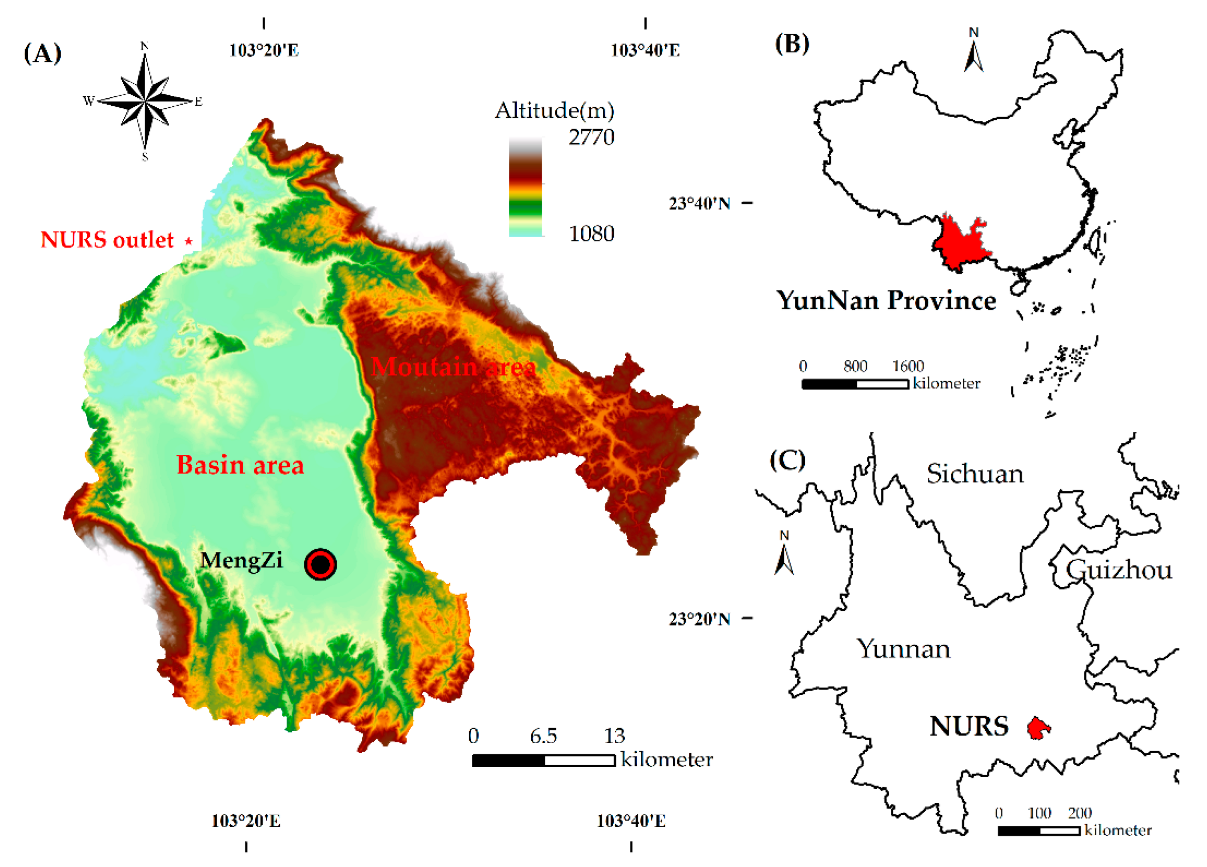
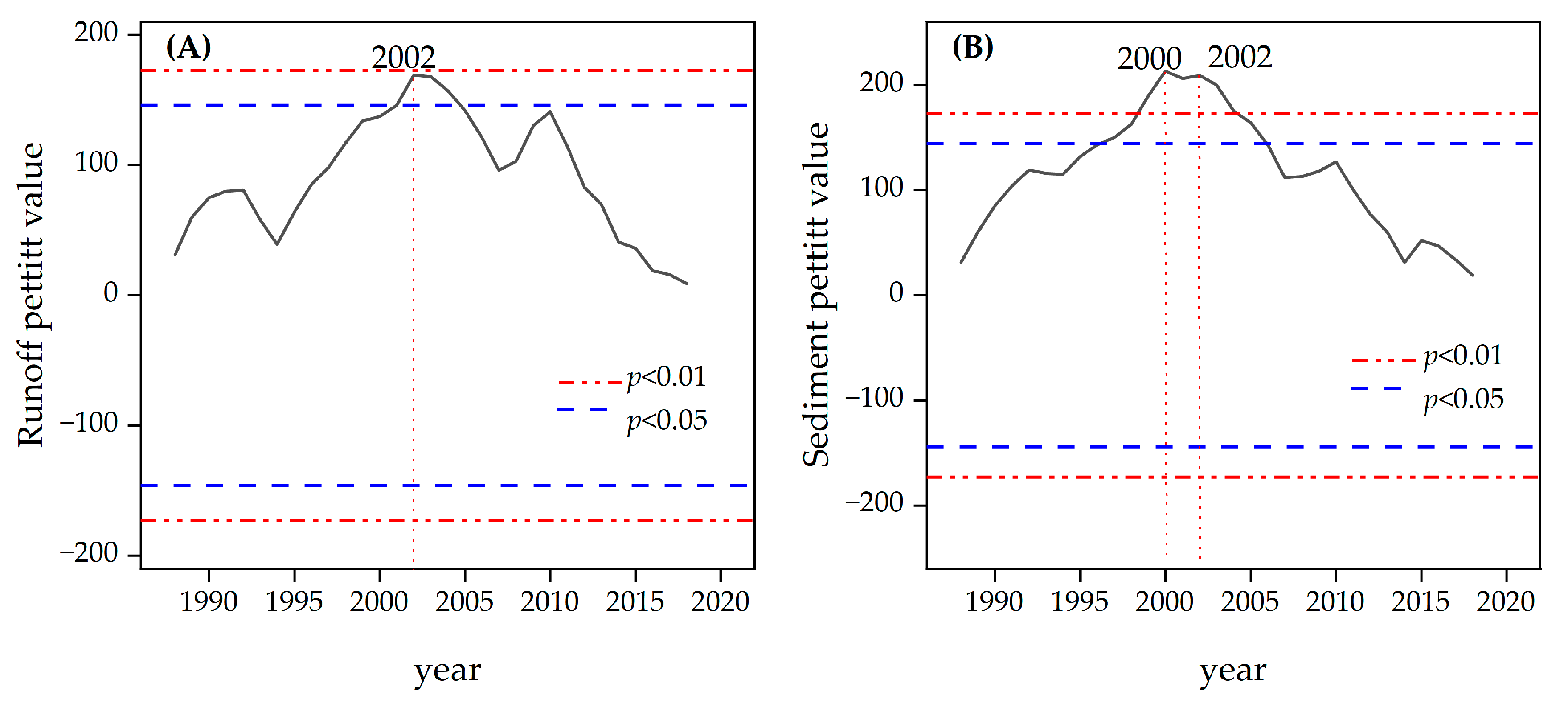
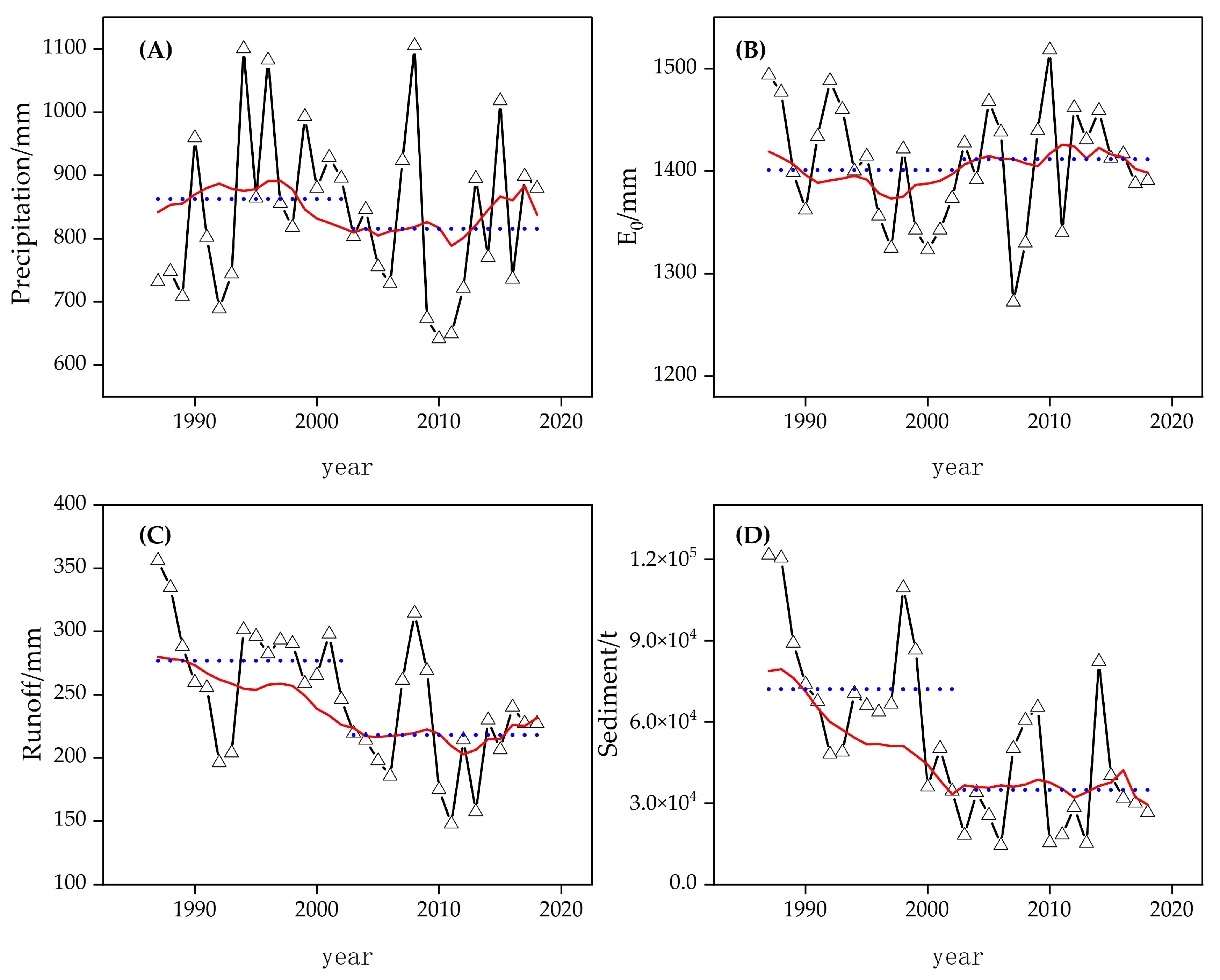
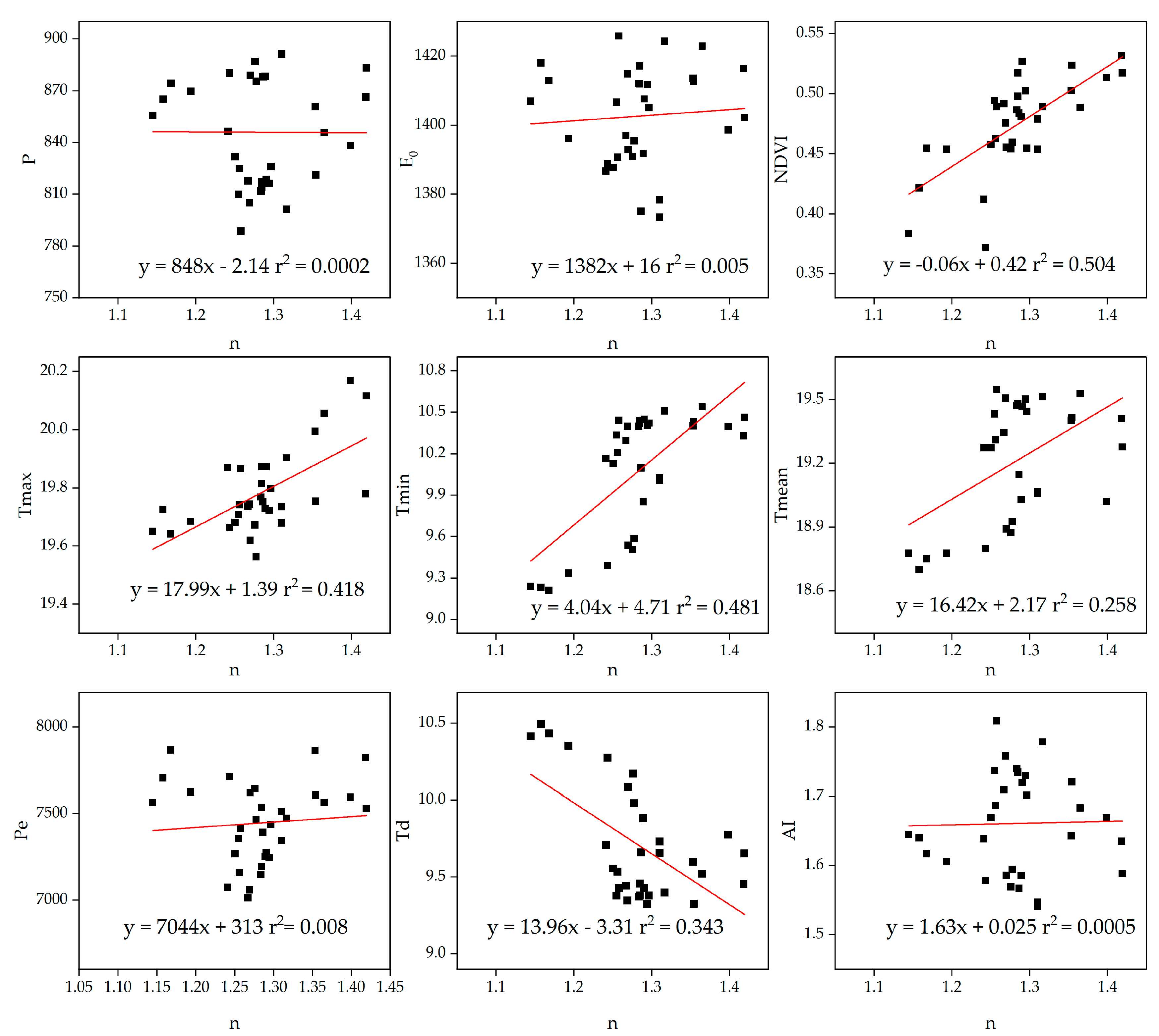
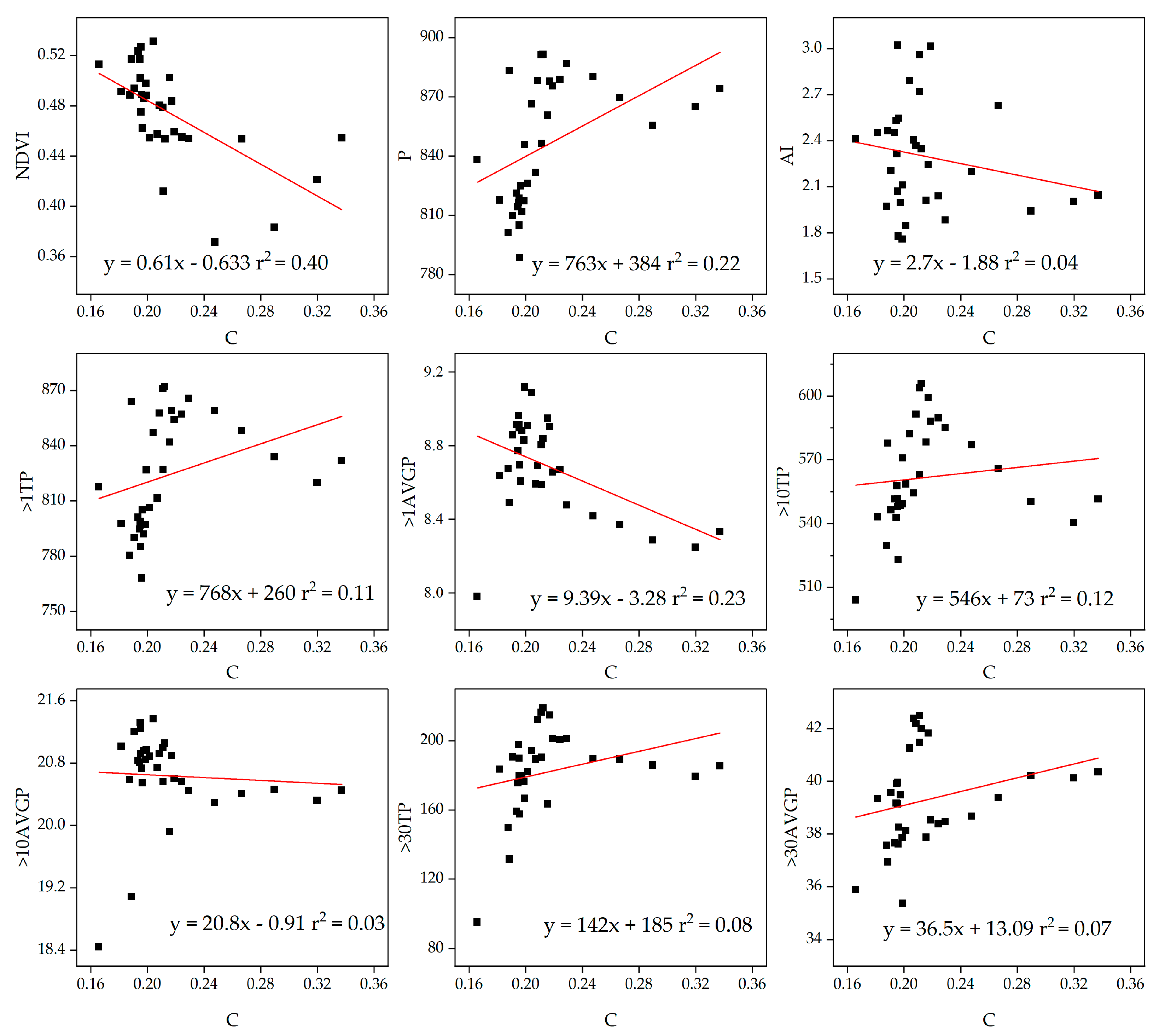
| Data | Resolution | Period | Project |
|---|---|---|---|
| Meteorological | day | 1987–2018 | Precipitation, Tmean, Tmax, Tmin, Wind speed, Sunshine duration, Relative humidity |
| NDVI | year/30 m | 1987–2018 | NDVI |
| Hydrologic | year | 1987–2018 | Runoff and Sfediment yield |
| P/mm | E0/mm | R/mm | S/t | |
|---|---|---|---|---|
| Before abrupt | 865.3 | 1392.6 | 257.8 | 71,985 |
| After abrupt | 826.5 | 1412.6 | 217.8 | 34,712 |
| Variable quantity | −38.8 | 20.0 | −40.0 | −37,273 |
| Proportion | 4.5% | 1.4% | 15.5% | 51.8% |
| Project | Tmax as x | Tmin as x | ||||||
|---|---|---|---|---|---|---|---|---|
| NDVI | Tmax | w1 | R2 | NDVI | Tmin | w1 | R2 | |
| Elasticity | 0.31 | 2.80 | −7.89 | 0.24 | 0.48 | −0.67 | ||
| p value | 0.001 | 0.006 | 0.0102 | 0.03 | 0.02 | 0.21 | ||
| Fitting | 0.61 | 0.57 | ||||||
| Project | P | E0 | NDVI | Tmax | R | |
|---|---|---|---|---|---|---|
| Elasticity | 1.88 | −0.88 | −0.40 | −3.61 | ||
| Variation/mm | −20.5 | −3.0 | −10.5 | −7.6 | −40.0 | −1.6 |
| Proportion | 51.2% | 7.5% | 26.1% | 18.9% | 100% | −3.7% |
| Project | P as z | >1 AVGP as z | ||||||
|---|---|---|---|---|---|---|---|---|
| NDVI | P | w2 | R2 | NDVI | >1 AVGP | w2 | R2 | |
| Elasticity | −1.0 | 1.30 | −11.08 | 0.24 | 0.48 | −0.67 | ||
| p value | 0.008 | 0.001 | 0.035 | 0.001 | −1.0 | 0.757 | ||
| Fitting | 0.51 | 0.45 | ||||||
| Project | R | C | S | |||||||
|---|---|---|---|---|---|---|---|---|---|---|
| P | E0 | NDVI | Tmax | NDVI | P | |||||
| Elasticity | 0.82 | 1.55 | −0.72 | −0.33 | −2.97 | 2.93 | −2.93 | 3.82 | ||
| Variation/t | −7384 | −3784 | −550 | −1929 | −1398 | −29889 | −17198 | −9354 | −37273 | |
| Proportion | 19.8% | 10.2% | 1.5% | 5.2% | 3.8% | 80.2% | 46.1% | 25.1% | 8.2% | |
Disclaimer/Publisher’s Note: The statements, opinions and data contained in all publications are solely those of the individual author(s) and contributor(s) and not of MDPI and/or the editor(s). MDPI and/or the editor(s) disclaim responsibility for any injury to people or property resulting from any ideas, methods, instructions or products referred to in the content. |
© 2023 by the authors. Licensee MDPI, Basel, Switzerland. This article is an open access article distributed under the terms and conditions of the Creative Commons Attribution (CC BY) license (https://creativecommons.org/licenses/by/4.0/).
Share and Cite
Liu, P.; Jiang, Z.; Li, Y.; Lan, F.; Sun, Y.; Yue, X. Quantitative Study on Improved Budyko-Based Separation of Climate and Ecological Restoration of Runoff and Sediment Yield in Nandong Underground River System. Water 2023, 15, 1263. https://doi.org/10.3390/w15071263
Liu P, Jiang Z, Li Y, Lan F, Sun Y, Yue X. Quantitative Study on Improved Budyko-Based Separation of Climate and Ecological Restoration of Runoff and Sediment Yield in Nandong Underground River System. Water. 2023; 15(7):1263. https://doi.org/10.3390/w15071263
Chicago/Turabian StyleLiu, Peng, Zhongcheng Jiang, Yanqing Li, Funing Lan, Yingjie Sun, and Xiangfei Yue. 2023. "Quantitative Study on Improved Budyko-Based Separation of Climate and Ecological Restoration of Runoff and Sediment Yield in Nandong Underground River System" Water 15, no. 7: 1263. https://doi.org/10.3390/w15071263
APA StyleLiu, P., Jiang, Z., Li, Y., Lan, F., Sun, Y., & Yue, X. (2023). Quantitative Study on Improved Budyko-Based Separation of Climate and Ecological Restoration of Runoff and Sediment Yield in Nandong Underground River System. Water, 15(7), 1263. https://doi.org/10.3390/w15071263






